
The Atlantic mackerel, also known as Boston mackerel, Norwegian mackerel, Scottish mackerel or just mackerel, is a species of mackerel found in the temperate waters of the Mediterranean Sea, the Black Sea, and the northern Atlantic Ocean, where it is extremely common and occurs in huge shoals in the pelagic zone down to about 200 m (660 ft). It spends the warmer months close to shore and near the ocean surface, appearing along the coast in spring and departing with the arrival of colder weather in the fall and winter months. During the fall and winter, it migrates out into deeper and more southern water, seeking warmer temperatures.
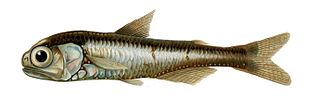
Lanternfishes are small mesopelagic fish of the large family Myctophidae. One of two families in the order Myctophiformes, the Myctophidae are represented by 246 species in 33 genera, and are found in oceans worldwide. Lanternfishes are aptly named after their conspicuous use of bioluminescence. Their sister family, the Neoscopelidae, are much fewer in number but superficially very similar; at least one neoscopelid shares the common name 'lanternfish': the large-scaled lantern fish, Neoscopelus macrolepidotus.

Ridgeheads, also known as bigscales, are a family of small, deep-sea stephanoberyciform fish. The family contains approximately 37 species in five genera; their distribution is worldwide, but ridgeheads are absent from the Arctic Ocean and Mediterranean Sea. Although the family is one of the most widespread and plentiful of deep-sea families, none of its members are of interest to commercial fishery.
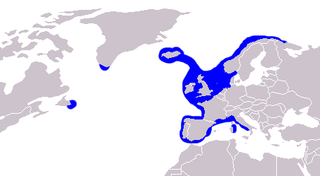
The common ling, also known as the white ling or simply the ling, is a large member of the family Lotidae, a group of cod-like fishes. It resembles the related rocklings, but it is much larger and has a single barbel. This species is unrelated to the pink ling, Genypterus blacodes, from the Southern Hemisphere. The common ling is found in the northern Atlantic, mainly off Europe, and into the Mediterranean Basin. It is an important quarry species for fisheries, especially in the northeastern Atlantic, although some doubts exist as the sustainability of the fisheries. As an edible species, it is eaten fresh, frozen, or dried, but also preserved in lye, while the roe is a delicacy in Spain.

Sloane's viperfish, Chauliodus sloani, is a predatory, mesopelagic dragonfish found in deep-pelagic waters across the world. The species was first described by German scientists Marcus Elieser Bloch and Johann Gottlob Schneider in their 1801 book Systema ichthyologiae: iconibus CX illustratum, volume 1. Its size can range from 64 mm to 260 mm, and it is an iridescent silver-blue color. It has two rows of photophores, one on each side of the ventral part of its body. It is believed that C. sloani adjusts the intensity of ventral photophores during diurnal migrations to camouflage itself from predators that might see its shadow from below.

Electrona is a genus of lanternfishes in the family Myctophidae.

Warming's lantern fish, Ceratoscopelus warmingii, is a lanternfish of the family Myctophidae, found circumglobally in both hemispheres, at depths of between 700 and 1,500 m during the day and between 20 and 200 m at night. Its length is about 8 cm (3.15 in).

The bignose shark is a species of requiem shark, in the family Carcharhinidae. Distributed worldwide in tropical and subtropical waters, this migratory shark frequents deep waters around the edges of the continental shelf. It is typically found at depths of 90–430 m (300–1,410 ft), though at night it may move towards the surface or into shallower water. The bignose shark is plain-colored and grows to at least 2.7–2.8 m (8.9–9.2 ft) in length. It has a long, broad snout with prominent nasal skin flaps, and tall, triangular upper teeth. Its pectoral fins are long and almost straight, and there is a ridge on its back between the two dorsal fins.

The whitesaddled catshark is a species of catshark, and part of the family Scyliorhinidae. It is found on the upper continental slope of the western central Atlantic Ocean, off the coasts of Honduras, Panama and Colombia, between latitudes 22° N and 9° N, at depths between 274 and 457 m. It can grow to a length of 47 cm (19 in). The reproduction of this catshark is oviparous but otherwise, little is known about its biology.

The red porgy, or common seabream, is a species of marine ray-finned fish in the family Sparidae. It is found in shallow waters on either side of the Atlantic Ocean, being present on the western coast of Europe and the Mediterranean Sea as well as the eastern coasts of North and South America and the Caribbean Sea. It feeds on or near the seabed and most individuals start life as females and later change sex to males.
Vinciguerria poweriae is a species of lightfish belonging to the genus Vinciguerria. They are mostly found in seawater 300–600 metres (1,000–2,000 ft) deep during the day and 50–350 metres (160–1,150 ft) deep at night. They feed on small crustaceans.

The European pilchard is a species of ray-finned fish in the monotypic genus Sardina. The young of the species are among the many fish that are sometimes called sardines. This common species is found in the northeast Atlantic, the Mediterranean, and the Black Sea at depths of 10–100 m (33–328 ft). It reaches up to 27.5 cm (10.8 in) in length and mostly feeds on planktonic crustaceans. This schooling species is a batch spawner where each female lays 50,000–60,000 eggs.

Argyropelecus affinis is a species of ray-finned fish in the family Sternoptychidae, found in the tropical and subtropical Atlantic, Indian and Pacific Oceans. Common names for this fish include Pacific hatchetfish, deepsea hatchetfish and slender hatchetfish. It inhabits the mesopelagic zone and is either non-migratory or performs short daily vertical migrations.

Argyropelecus sladeni is a species of ray-finned fish in the family Sternoptychidae, found in the tropical and subtropical Atlantic, Indian and Pacific Oceans. This small fish lives in the mesopelagic zone by day and makes a daily vertical migration to the epipelagic zone at night.
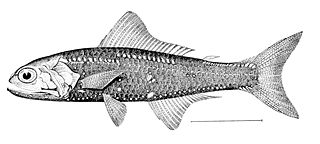
Notoscopelus resplendens, commonly known as the patchwork lampfish or patchwork lanternfish, is a species of lanternfish in the family Myctophidae. It is found in the eastern and western Atlantic Ocean, the Indian Ocean and parts of the Pacific Ocean. It spends the daylight hours in deep water, rising at night to near the surface. This fish was first described by the Scottish naturalist and arctic explorer John Richardson in 1845.
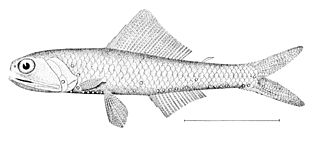
Notoscopelus caudispinosus is a species of lanternfish in the family Myctophidae. It is found in the eastern and western Atlantic Ocean, the Indian Ocean and parts of the Pacific Ocean. It spends the day below 1,000 m (3,300 ft), rising towards the surface to feed at night.
Notoscopelus bolini is a species of lanternfish in the family Myctophidae. It is found in the North Atlantic Ocean and the Mediterranean Sea. It was first described in 1975 by the American ichthyologist Basil Nafpaktitis and named in honour of the American marine biologist Rolf Ling Bolin who had reviewed the genus in 1959.
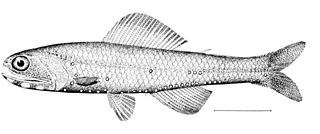
Notoscopelus kroyeri, commonly known as the lancet fish, is a species of lanternfish in the family Myctophidae. It is endemic to the North Atlantic Ocean where it is found in deep water habitats, spending its day at great depths and its night near the surface. It was previously regarded by some authorities as being a subspecies of Notoscopelus elongatus; one of the differences between the two being that N. elongatus has 25 or fewer gill rakers while N. kroyeri has 26 or more.

Exocoetus obtusirostris, commonly known as the oceanic two-wing flyingfish or the blunt-snouted flyingfish, is a species of ray-finned fish native to the tropical and subtropical western Atlantic Ocean. It has the ability to glide above the surface of the water to escape from predators.

The lesser amberjack, also known as the false amberjack or little amberjack, is a species of ray-finned fish from the family Carangidae, the jacks and pompanos. It occurs in the Atlantic Ocean. In the western Atlantic it ranges from Massachusetts in the north along the eastern Coast of the United States and into the Gulf of Mexico as far south as Tamaulipas. In the Caribbean Sea it is found off Cuba and Barbados and from Santa Marta, Colombia to Isla la Tortuga, Venezuela. It is also found around Bermuda. In the eastern Atlantic its distribution reaches north to Spain and the Mediterranean Sea to Ghana as well as being found around the Canary Islands, Azores, Madeira and St Helena. It is a benthopelagic, predatory species, the adults feed on smaller fish and cephalopods. The adults occur close to or on the bottom at depths of 55–130 metres (180–427 ft) while the larger juveniles are pelagic or benthic in the waters of the continental shelf and the smaller juveniles are found in oceanic or offshore waters.



















